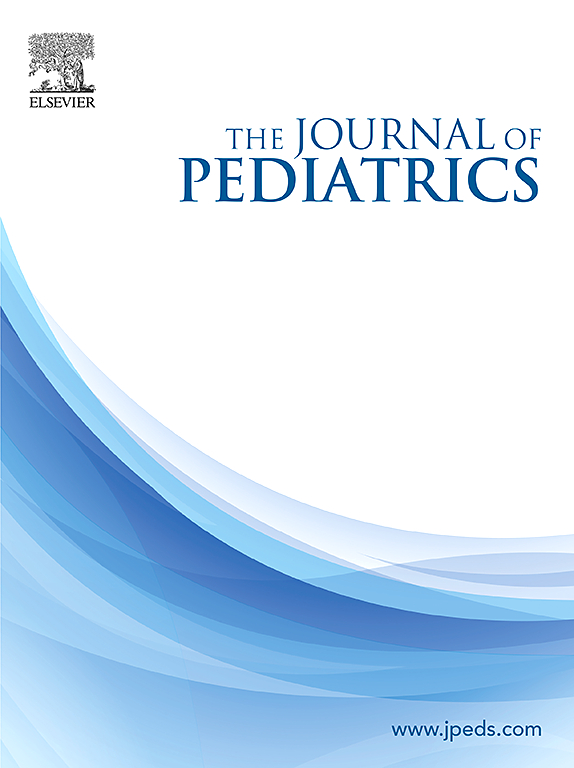IF 3.9
2区 医学
Q1 PEDIATRICS
引用次数: 0
摘要
目标:描述当代胎龄儿群组的结果研究设计:分析多中心、跨国 CDH 研究小组 (CDHSG) 登记的 1995 年至 2022 年出生患者的数据。评估变量包括产前特征和治疗、产后管理和出院后的结果。连续变量采用t检验,分类变量采用费舍尔精确检验:在研究期间,有 13471 名 CDH 患者被纳入登记册。810人(6%)出生时体重不足34周。早产儿的存活率为 45%,43.5% 的患者未接受修复。手术修复后的存活率为 79%,平均手术年龄为 11 天(DOL),65% 需要修补修复。只有 7% 的病例使用了体外生命支持系统 (ECLS),35% 的病例存活。48.9%的病例伴有异常。76.7% 的婴儿在出生后 30 天内需要吸氧。极早产(结论:早产 CDH 婴儿的存活率仍然很低,FETO 的实施很可能会增加 CDH 早产率。未修复率高是导致存活率较低的重要原因,更积极地使用 ECLS 和手术修复可能会提高存活率。本文章由计算机程序翻译,如有差异,请以英文原文为准。
Prematurity and Congenial Diaphragmatic Hernia: Revisiting Outcomes in a Contemporary Cohort
Objective
To describe outcomes in a contemporary cohort of infants born at gestational age <34 weeks with congenital diaphragmatic hernia (CDH).
Study design
Data from the multicenter, multinational CDH Study Group (CDHSG) registry on patients born between 1995 and 2022 were analyzed. Variables including prenatal characteristics and therapy, postnatal management, and outcomes to discharge were evaluated. A t test was used for continuous variables, and for categorical variables, the Fisher exact test.
Results
In total, 13 471 patients with CDH were entered into the registry during the study period. 810 (6%) were born at < 34 weeks of gestational age. The survival rate for the preterm cohort was 45%, and 43.5% were not repaired. Survival after surgical repair was 79%, mean age at surgery was 11 days of life, and 65% required patch repair. Extracorporeal life support was used in only 7% of the cases, and 35% survived. In total, 48.9% had an associated anomaly. Oxygen at 30 days of life was required by 76.7%. Very preterm birth (<32 weeks of gestational age) occurred in 361 patients (2.8%), with a 39.3% survival rate and a high rate of nonrepairs (50.1%). The incidence of birth at <34 weeks of gestational age for those undergoing fetal tracheal occlusion was 30%.
Conclusions
Survival rates for infants born preterm with CDH remain low and the implementation of fetal tracheal occlusion is likely to increase the rate of prematurity in CDH. The high rate of nonrepair is a significant contributor to lower survival, and the more aggressive use of extracorporeal life support and surgical repair may improve survival.
求助全文
通过发布文献求助,成功后即可免费获取论文全文。
去求助
来源期刊

Journal of Pediatrics
医学-小儿科
CiteScore
6.00
自引率
2.00%
发文量
696
审稿时长
31 days
期刊介绍:
The Journal of Pediatrics is an international peer-reviewed journal that advances pediatric research and serves as a practical guide for pediatricians who manage health and diagnose and treat disorders in infants, children, and adolescents. The Journal publishes original work based on standards of excellence and expert review. The Journal seeks to publish high quality original articles that are immediately applicable to practice (basic science, translational research, evidence-based medicine), brief clinical and laboratory case reports, medical progress, expert commentary, grand rounds, insightful editorials, “classic” physical examinations, and novel insights into clinical and academic pediatric medicine related to every aspect of child health. Published monthly since 1932, The Journal of Pediatrics continues to promote the latest developments in pediatric medicine, child health, policy, and advocacy.
Topics covered in The Journal of Pediatrics include, but are not limited to:
General Pediatrics
Pediatric Subspecialties
Adolescent Medicine
Allergy and Immunology
Cardiology
Critical Care Medicine
Developmental-Behavioral Medicine
Endocrinology
Gastroenterology
Hematology-Oncology
Infectious Diseases
Neonatal-Perinatal Medicine
Nephrology
Neurology
Emergency Medicine
Pulmonology
Rheumatology
Genetics
Ethics
Health Service Research
Pediatric Hospitalist Medicine.
 求助内容:
求助内容: 应助结果提醒方式:
应助结果提醒方式:


